
TRT Podcast #90: The what and why of explicit instruction
Does the phrase “explicit instruction” make you think of “drill and kill”? The good news is that explicit instruction isn’t about boring teaching … it’s about GOOD teaching. Learn exactly what explicit instruction is, and why it’s important for student success.
Listen to the episode here
Full episode transcript
Hello, Anna Geiger here with you for Episode 90 of the podcast! This episode is brought to you by the Measured Mom Plus, which is my online membership site for teachers and homeschoolers of pre-K through third grade. The membership is home to thousands of printable resources, as well as no-print resources and workshops that will help you teach reading well. One of our members, Linda, had this to say, "The best purchase I've made as a teacher is the yearly subscription to the membership. It's great to have so many resources and games with engaging, productive activities that students love." To learn more, visit themeasuredmom.com/join.
Today in Episode 90, we're starting a series all about explicit instruction. Before we get into that, we need to talk about the difference between the science of reading and the art of teaching.
As you know, the science of reading is the body of research about how we learn to read and how to best teach reading.
The art of teaching has to do with how we communicate that information to students, because you can know all of the research, but if you don't know HOW to teach it, of course, your students aren't going to learn. So the art of teaching includes things like how you structure your lessons, how you communicate information to students, how you involve them in the lessons, how you give feedback, how you help them stay on task, and how you make sure that they're actually learning it.
Explicit instruction has to do with the how, the art of teaching. For a definition of explicit instruction, we can best go to Dr. Anita Archer, who is really the primary expert on explicit instruction. She has written a wonderful book with Charles Hughes called "Explicit Instruction," and she has given many online presentations about it. Just look for her on YouTube and you'll find lots of helpful workshops.
I'm going to take a clip from one of those and share with you her definition of explicit instruction, "Explicit instruction simply is instruction that is quite direct. It is unambiguous with the goal that the students would get it, would understand it, and would learn."
You may have noticed that Dr. Archer used the word direct in her definition. Sometimes I use the phrases "explicit instruction" and "direct instruction" interchangeably, and I think they're pretty much the same thing, except when direct instruction has a capital D and I.
Capital "Direct Instruction" is actually different. It has the same principles of lowercase explicit instruction because it includes focusing on structured lessons, increasing on-task behaviors, and teaching content, but the difference is that it's actually a method designed by Siegfried Engelmann and Dr. Wesley Becker. In their method, there's a very specific way to teach the lessons and sometimes they're even scripted. So, just be aware that lowercase direct instruction and uppercase direct instruction are two different things.
Now, I'll be honest and tell you that explicit instruction left a bad taste in my mouth for a long time because I associated it with drill and kill, the idea that if you practice and practice something, you will kill a student's love of learning.
Well, I like what Dr. Archer has to say about this, "I constantly hear people say, 'Well, you know, Anita, that is just drill and kill, drill and kill.' But I can tell you, we have no reported incidents of children dying of practice."
So there was actually a big research study that helped us understand that direct instruction, this direct teaching of concepts and skills, is superior to other methods, and it was called Project Follow Through. It's the most extensive educational experiment ever conducted. It began in 1968, it was sponsored by the federal government, and the goal was to determine the best way to teach at-risk children from kindergarten through third grade. The study took about nine years and it included over 200,000 children in 178 communities. They were taught using one of 22 different models of instruction, one of which was direct instruction. The 200,000 children represented a variety of ethnicities, and they were from different socioeconomic backgrounds, so this was a very good study.
What they found in 1977 when they looked at the results was that Direct Instruction blew the other approaches out of the water when it came to academic learning! Students learned much more and much better with the Direct Instruction approach. Also, these students had more self-esteem and self-confidence, even more than the approaches that were actually designed to improve self-confidence and self-esteem.
Dr. Archer likes to say that success breeds motivation. The self-confidence came from actually learning the information, which comes through explicit instruction.
Now, you should know that with this study, we're talking about Direct Instruction with a capital letter, so this was a specific way to teach explicitly, but it was the only method of all of them that really focused on explicit teaching.
By the way, subsequent research found that the Direct Instruction students continued to outperform their peers and were more likely to finish high school and go to college. The research is clear, direct instruction is superior when it comes to helping students actually learn the material.
So, what exactly is included with explicit instruction? We know it's direct, we know it's very clear, but what else? Well, in their book, "Explicit Instruction," Anita Archer and Charles Hughes have a list of sixteen elements of explicit instruction, and I'm just going to look at a few of those with you today.
When you are teaching explicitly, you're going to have organized and focused lessons. You won't be teaching off the cuff, you'll have prepared a lesson, and you'll have a plan for how things are going to go.
The lesson follows through a logical sequence.
You're going to begin your lesson with a clear statement of the goals and your expectations of your students.
You're going to make sure you review previously learned skills and knowledge before starting.
Your lesson may include a step-by-step demonstration.
You're going to have guided and supported practice using the I Do, We Do, You Do Model, which we'll talk about next week.
You are going to require frequent responses. Sometimes I think that when we think about explicit or direct instruction, we assume it's the teacher lecturing from the front of the room and the kids are sitting at their desks bored, but that's really not true because we know that the art of teaching would tell us that for students to really be learning, they have to be active.
Explicit instruction involves lots of responses from the students, and there's a trick for this, how to incorporate those frequent responses in your lessons, and that's why one of our episodes in this series is going to be about keeping students engaged during the lesson.
You want to provide immediate and corrective feedback.
You want to teach at a brisk pace. You certainly want to go slow enough so that students can think and process, but you want it to be fast enough that they're not going to get bored. Anita Archer calls this "moving at a perky pace."
Finally, you want to make sure that you are providing lots of opportunities for practice. Let's hear what Anita Archer has to say about that,
"The students need deliberate practice where they're practicing with a purpose. They need practice that is spaced over time, not all in one session, and they need to retrieve information in that practice. So it's a combination of very explicit instruction with I Do It, We Do It, You Do It, followed with deliberate and spaced practice and retrieval."
So, there you go. This was our first episode in the series, An Introduction to Explicit Instruction. In the show notes for today's episode, you'll find a link to Anita Archer's book, as well as that video on YouTube in which she elaborates more on explicit instruction. You can find the show notes at themeasuredmom.com/episode90. See you next week!
Sign up to receive email updates
Enter your name and email address below and I'll send you periodic updates about the podcast.
Related links
- Explicit Instruction, by Anita L. Archer and Charles A. Hughes
- Why Explicit Instruction? video with Anita Archer on Center for Dyslexia MTSU
- Project Follow Through







Leave a Comment